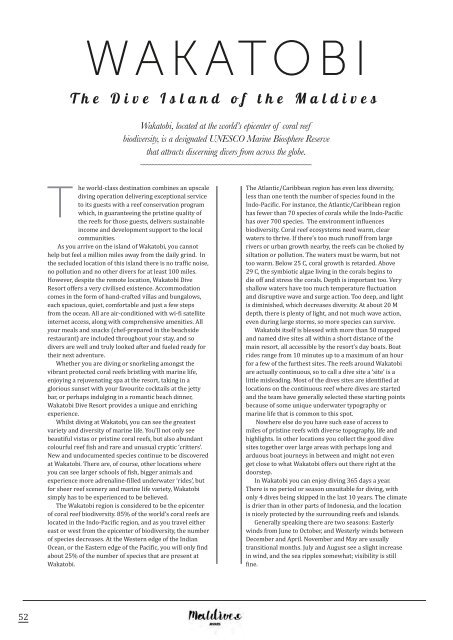You also want an ePaper? Increase the reach of your titles
YUMPU automatically turns print PDFs into web optimized ePapers that Google loves.
WAKATOBI<br />
The Dive Island of the Maldives<br />
Wakatobi, located at the world’s epicenter of coral reef<br />
biodiversity, is a designated UNESCO Marine Biosphere Reserve<br />
that attracts discerning divers from across the globe.<br />
The world-class destination combines an upscale<br />
diving operation delivering exceptional service<br />
to its guests with a reef conservation program<br />
which, in guaranteeing the pristine quality of<br />
the reefs for those guests, delivers sustainable<br />
income and development support to the local<br />
communities.<br />
As you arrive on the island of Wakatobi, you cannot<br />
help but feel a million miles away from the daily grind. In<br />
the secluded location of this island there is no traffic noise,<br />
no pollution and no other divers for at least 100 miles.<br />
However, despite the remote location, Wakatobi Dive<br />
Resort offers a very civilised existence. Accommodation<br />
comes in the form of hand-crafted villas and bungalows,<br />
each spacious, quiet, comfortable and just a few steps<br />
from the ocean. All are air-conditioned with wi-fi satellite<br />
internet access, along with comprehensive amenities. All<br />
your meals and snacks (chef-prepared in the beachside<br />
restaurant) are included throughout your stay, and so<br />
divers are well and truly looked after and fueled ready for<br />
their next adventure.<br />
Whether you are diving or snorkeling amongst the<br />
vibrant protected coral reefs bristling with marine life,<br />
enjoying a rejuvenating spa at the resort, taking in a<br />
glorious sunset with your favourite cocktails at the jetty<br />
bar, or perhaps indulging in a romantic beach dinner,<br />
Wakatobi Dive Resort provides a unique and enriching<br />
experience.<br />
Whilst diving at Wakatobi, you can see the greatest<br />
variety and diversity of marine life. You’ll not only see<br />
beautiful vistas or pristine coral reefs, but also abundant<br />
colourful reef fish and rare and unusual cryptic ‘critters’.<br />
New and undocumented species continue to be discovered<br />
at Wakatobi. There are, of course, other locations where<br />
you can see larger schools of fish, bigger animals and<br />
experience more adrenaline-filled underwater ‘rides’, but<br />
for sheer reef scenery and marine life variety, Wakatobi<br />
simply has to be experienced to be believed.<br />
The Wakatobi region is considered to be the epicenter<br />
of coral reef biodiversity. 85% of the world’s coral reefs are<br />
located in the Indo-Pacific region, and as you travel either<br />
east or west from the epicenter of biodiversity, the number<br />
of species decreases. At the Western edge of the Indian<br />
Ocean, or the Eastern edge of the Pacific, you will only find<br />
about 25% of the number of species that are present at<br />
Wakatobi.<br />
The Atlantic/Caribbean region has even less diversity,<br />
less than one tenth the number of species found in the<br />
Indo-Pacific. For instance, the Atlantic/Caribbean region<br />
has fewer than 70 species of corals while the Indo-Pacific<br />
has over 700 species. The environment influences<br />
biodiversity. Coral reef ecosystems need warm, clear<br />
waters to thrive. If there’s too much runoff from large<br />
rivers or urban growth nearby, the reefs can be choked by<br />
siltation or pollution. The waters must be warm, but not<br />
too warm. Below 25 C, coral growth is retarded. Above<br />
29 C, the symbiotic algae living in the corals begins to<br />
die off and stress the corals. Depth is important too. Very<br />
shallow waters have too much temperature fluctuation<br />
and disruptive wave and surge action. Too deep, and light<br />
is diminished, which decreases diversity. At about 20 M<br />
depth, there is plenty of light, and not much wave action,<br />
even during large storms, so more species can survive.<br />
Wakatobi itself is blessed with more than 50 mapped<br />
and named dive sites all within a short distance of the<br />
main resort, all accessible by the resort’s day boats. Boat<br />
rides range from 10 minutes up to a maximum of an hour<br />
for a few of the furthest sites. The reefs around Wakatobi<br />
are actually continuous, so to call a dive site a ‘site’ is a<br />
little misleading. Most of the dives sites are identified at<br />
locations on the continuous reef where dives are started<br />
and the team have generally selected these starting points<br />
because of some unique underwater typography or<br />
marine life that is common to this spot.<br />
Nowhere else do you have such ease of access to<br />
miles of pristine reefs with diverse topography, life and<br />
highlights. In other locations you collect the good dive<br />
sites together over large areas with perhaps long and<br />
arduous boat journeys in between and might not even<br />
get close to what Wakatobi offers out there right at the<br />
doorstep.<br />
In Wakatobi you can enjoy diving 365 days a year.<br />
There is no period or season unsuitable for diving, with<br />
only 4 dives being skipped in the last 10 years. The climate<br />
is drier than in other parts of Indonesia, and the location<br />
is nicely protected by the surrounding reefs and islands.<br />
Generally speaking there are two seasons: Easterly<br />
winds from June to October, and Westerly winds between<br />
December and April. November and May are usually<br />
transitional months. July and August see a slight increase<br />
in wind, and the sea ripples somewhat; visibility is still<br />
fine.<br />
52

















